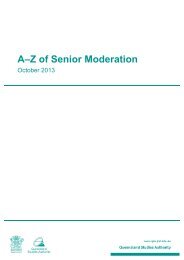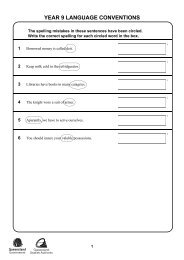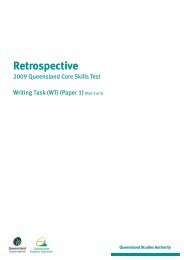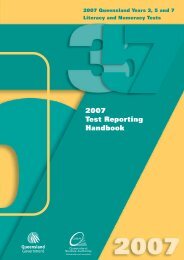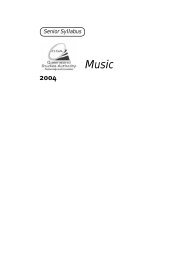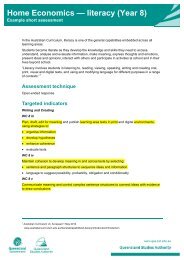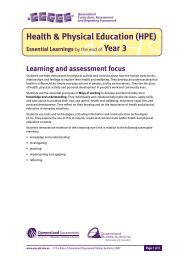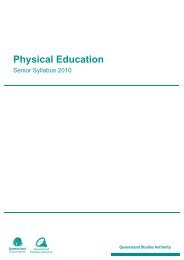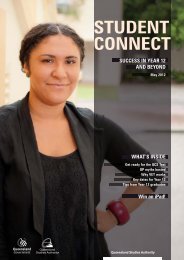Set 3 â Sample Reading test answers - NAPLAN Year 5 Literacy
Set 3 â Sample Reading test answers - NAPLAN Year 5 Literacy
Set 3 â Sample Reading test answers - NAPLAN Year 5 Literacy
Create successful ePaper yourself
Turn your PDF publications into a flip-book with our unique Google optimized e-Paper software.
<strong>NAPLAN</strong> — <strong>Year</strong> 5 <strong>Literacy</strong><br />
<strong>Set</strong> 3 — <strong>Sample</strong> <strong>Reading</strong> <strong>test</strong> <strong>answers</strong><br />
About the sample <strong>Reading</strong> <strong>test</strong>s<br />
The materials have been designed so that they can be used as individual units or as a mini-<strong>test</strong> paper incorporating a<br />
number of reading units.<br />
Teachers in all subject areas should take note of the type of reading skill signalled in these <strong>test</strong>s and incorporate explicit<br />
teaching and assessment of reading skills in their own subject area lessons.<br />
These sample <strong>Reading</strong> <strong>test</strong> units could be used to show strategies such as<br />
• Question Answer Relationships (QARs), including a stage in which students write their own questions based on the<br />
stimulus texts<br />
• text location strategies such as “key word in the margin”<br />
• inferential questions, both those that are text-based and those that are context-based<br />
• responding to evaluation questions<br />
• persistence and stamina.<br />
Answers<br />
Energy from Food<br />
The Bully Asleep<br />
1 C; 2 A; 3 B; 4 C; 5 D; 6 C; 7 A; 8 C; 9 D<br />
10 A; 11 C; 12 B; 13 D; 14 C; 15 A; 16 D; 17*; 18 B<br />
Sharks Need Protecting Too 19 C; 20 C; 21 A; 22 D; 23 A; 24*; 25 C; 26 A; 27 B; 28*<br />
*Model responses for write-in (short response) questions<br />
Question 17:<br />
The endings of the second line and last line of every verse of this poem rhyme with each other. In verse 5, which words<br />
make the rhyme?<br />
Full credit: hid it and did it.<br />
Partial credit: it and it.<br />
Question 24:<br />
Write the numbers 1 to 5 in the boxes to put the statements in the order they would occur.<br />
3. Fishermen cut off fins.<br />
2. Fishermen catch a shark.<br />
1. Sharks swim freely in the sea.<br />
5. Sea creatures feed on injured animals.<br />
4. Sharks sink to the bottom of the ocean.<br />
Question 28*:<br />
The text attempts to persuade readers to a point of view.<br />
Give some examples of how the language in the text has been used to persuade the reader.<br />
Correct:<br />
Students would need to identify 2 or more examples with some explanation of how they are used. These may include:<br />
• words that make you feel sad or angry like malicious practices, inhumane acts.<br />
• sharks are described as defenceless and dying to make us change our ideas about sharks<br />
• the author compares a common view, sharks are mean killers, with a view of them as a victim when they have their fins
chopped off<br />
• shark finning is described using horrifying words like “chopping off the shark’s fins while they are still alive” to<br />
make us feel that this is a horrible thing to do<br />
• Words like die, doomed, suffocating, eaten alive make you feel sorry for sharks<br />
• the author describes in a logical order what happens to a shark when it is caught for its fins. This gives the<br />
reader information to help them understand something they may know nothing about: what actually happens<br />
when a shark has its fins cut off.<br />
Incorrect:<br />
ideas are not related to persuasive techniques, list of techniques without explanation of their purpose or use,<br />
ideas not related to the author’s argument or ideas that give information rather than explaining persuasive<br />
techniques. These may include:<br />
• feelings words<br />
• feared killer, sharks, danger<br />
• sharks are mean killers<br />
• sharks are cut up for their fins<br />
• sharks are dying because fishermen cut off their fins.<br />
References<br />
Raphael, TE, Highfield, K & Au, KH 2006, QAR Now: Question and answer relationships, Scholastic, New York.<br />
Beck, IL, McKeown MG & Kucan, L 2006, Improving comprehension with questioning the author: A fresh and<br />
expanded view of a powerful approach, Scholastic, New York.<br />
Harvey, S & Goudvis, A 2000, Strategies that work: Teaching comprehension to enhance understanding,<br />
Stenhouse, Portland.<br />
Alvermann, DE & Phelps, SF 1998, Content reading and literacy, 2nd ed, Allyn and Bacon, Boston.<br />
Resources<br />
Resources on the QSA website that may be useful include:<br />
• Poster: In the book or in your head — www.qsa.qld.edu.au/1443.html<br />
• Teacher’s notes: Locating information — www.qsa.qld.edu.au/1443.html<br />
• Poster: Thinking about a story — www.qsa.qld.edu.au/1443.html<br />
• Teaching reading and viewing: Guide for <strong>Year</strong>s 4–7 — www.qsa.qld.edu.au/yr5-english-resources.html<br />
• Teaching reading and viewing: Comprehension strategies — www.qsa.qld.edu.au/yr5-english-resources.html<br />
• Framework for <strong>Reading</strong> items — www.qsa.qld.edu.au/1443.html.<br />
Acknowledgments<br />
John Walsh and the Oxford University Press, London, for the text of the poem “The bully asleep”, published in The<br />
roundabout by the sea and other verses for children, 1960.<br />
2 | <strong>Literacy</strong>



